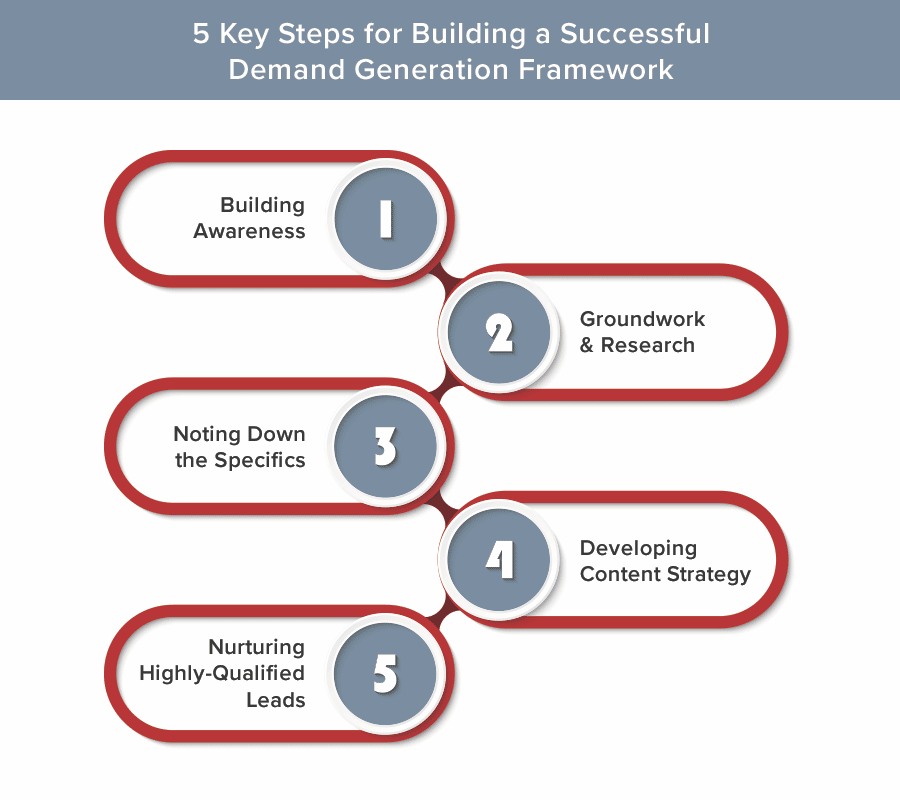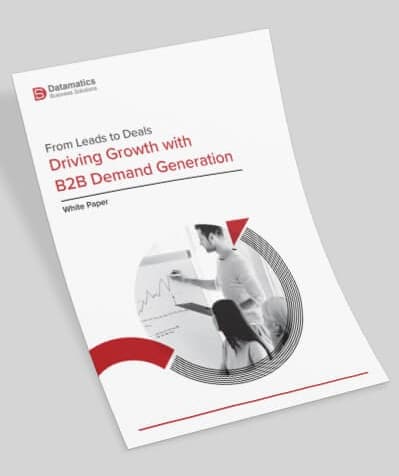Demand generation is the art of getting the customers that your business deserves. For most B2B organizations, demand generation is an inbound marketing strategy that leverages data to create awareness, popularity, and interest from your prospects towards your brand and product. The process is focused predominantly on the top of the sales funnel.
For this reason, building a demand generation framework requires special consideration to create strategies that can empower and educate your prospects so that they see you as the perfect solution to their pain points.
In this blog, we will walk you through the difference between demand generation and lead generation, tips to implement an effective demand generation framework and optimize it. But before we move forward, let us revisit the primary definition of demand generation to refresh our memories.
What is Demand Generation?
In a nutshell, demand generation could entail a whole range of activities, including activities to boost brand awareness, exercises to increase long-term engagement with the brand, and a set of processes that position your product or service as the ideal solution in front of the right customers. All this while considering every single touchpoint throughout the customer’s journey.
It is also the most simplistic approach to look at demand generation and the easiest way to differentiate it from lead generation, which often gets used interchangeably with demand gen, but ideally, it should be and is different.
With that out of the way, let us begin our journey toward building a demand-generation framework. Let’s look at some of the critical elements that can make your demand-generation framework a success.
Demand Generation Vs. Lead Generation
Demand generation is all about building awareness and interest in a business’s offerings, often targeting new audiences. In contrast, lead generation focuses on converting highly interested prospects into customers.
These two approaches operate at different points within the B2B sales funnel. Demand generation primarily occurs at the top of the funnel, engaging potential customers in the buying process, such as when they visit your website or social media pages. On the other hand, lead generation takes place once prospects have shown sufficient interest, willing to exchange personal information, like signing up for a demo through a landing page.
It’s important to note that lead generation is a subset of demand generation, situated further down the sales funnel. Therefore, if you’re struggling to generate demand, it may be due to a lack of SQL (Sales Qualified Leads).
In reality, it’s not an either/or situation; successful modern marketers should focus on both lead generation and demand generation. These strategies complement each other and should be used together to maximize results.
The Role of Demand Generation in B2B Marketing
The primary goal of any demand generation campaign is to spark interest in a company’s products and services. As a result, it also generates leads, ultimately leading to increased sales.
• Boosting Brand Awareness
The core objective of any effective demand generation campaign should be to enhance brand awareness. By increasing the recognition of your brand, you naturally broaden the exposure of your company and the offerings it provides to potential customers.
• Quality Leads
Demand generation plays a crucial role in capturing quality leads by guiding potential customers from awareness to genuine interest. Through targeted marketing and educational content, it identifies those with a sincere interest, marking them as high-quality leads. Lead scoring further aids in prioritizing efforts. These nurtured leads not only have a higher conversion potential but also tend to become loyal, contributing significantly to ROI.
• Competitive Edge
Demand generation is a linchpin in secuing a competitive advantage for businesses. By strategically creating awareness and interest in their products or services, companies can distinguish themselves from rivals.
When potential customers are exposed to engaging and informative content through demand generation efforts, it not only elevates brand recognition but also positions the company as a thought leader in its industry.
This perceived expertise builds trust and credibility, which can be pivotal in winning over customers in a crowded marketplace.
• Lead Generation
Demand generation also contributes significantly to lead generation. When it creates brand awareness, it generates valuable leads and builds a strong potential customer database, which can later be nurtured and converted into sales.
• Improved Sales Efficiency
Through the establishment of brand awareness and a solid prospect database, demand generation greatly enhances the effectiveness of your sales team, making their efforts more efficient.
• Increased Customer Loyalty
Demand generation not only attracts new customers but also retains existing ones. This increases the likelihood of repeat purchases and cultivates brand loyalty among your customer base.
Demand generation is a vital part of B2B marketing, driving customer interest in your products and services, enabling lead generation, enhancing sales efficiency, and fostering customer retention. By building brand recognition, driving lead generation, streamlining sales efforts, and cultivating customer loyalty, demand generation helps you achieve your marketing goals and expand your business.
5 Key Steps for Building a Successful Demand Generation Framework
Step 1: Building Awareness
Brand awareness for any business, irrespective of its domain and nature, is critical to maintaining a consistent and healthy flow of leads. Whether you operate in a B2B domain or are a B2C business, the current sales and marketing landscape requires a strong brand presence.
And although building brand awareness seems a relatively straightforward task, it is far from anything specific, for it isn’t only about gathering the attention of a potential customer.
To have a solid brand awareness strategy, you need to build a lingering, positive impression of your brand in the minds of your prospects. And the easiest way to do so is to present your product or service as the ideal solution to the customer’s needs or challenges.
The easiest way is to listen to your customers’ and prospects’ feedback. You can also use the existing customer data to identify your customers’ pain points. This will help you tailor your services and products to meet the need of your customers and consequently build awareness toward them.
Step 2: Do the Groundwork
Building a successful demand generation framework will require you to put in some serious groundwork and research to understand your customers’ actual needs. Thus, it would be best to lay the groundwork well. Some easy ways to do so include –
- Building Ideal Customer Profiles (ICPs)
- Building Buyer Personas
- Analyzing Customer Feedback/Reviews
- Defining Customer Segments
- Analyzing Buying Patterns
- Mapping Solutions to Buyer Personas
Each of these steps will help you understand your customers better and the best mode of communication/channel to approach them with your demand-generation tactics. This will also help you tailor your messaging to resonate well with your customers.
Step 3: Chalk Down the Specifics
Once you’ve built the awareness and done your groundwork, the next logical step to have a demand generation framework with maximum impact is to chalk down the specifics of your demand generation campaign.
Depending upon the nature of the campaign you intend to run, these specifics could include several small steps. To help you with it, here are some of the specifics you will want to address –
- Marketing Channels: Inbound, Outbound, Social Media, Events Etc.
- Length of the campaign with specifics such as time, period, days Etc.
- Type of content that will sit well with your audience.
- Marketing Budget
- KPIs: lead generation, brand awareness, brand awareness, qualified leads Etc.
Each of these steps will further unfurl the path ahead for your demand generation framework by giving you the next actionable item in your course to build a demand generation framework that will work just as you want it to.
Step 4: Content Creation
Creating content for demand generation or lead generation is a no-brainer. Yet, the number of perplexed marketers pondering over the cause behind the failure of their campaigns is just unrealistically high.
The number of times you will hear, “We did create killer content for our campaigns, wonder why it failed?” during a marketing meeting is impressive. And the main reason behind such a high fatality rate when it comes to demand generation content is that the marketeers often miss Step 3.
We consume all sorts of content daily, be it brand-generated or UGC (User Generated Content), yet the content that mostly stays with us is the content that we can relate to most. This is why, despite the content being King, it is of no use if you are not creating user-centric content. The best demand generation framework will always stress creating personalized and relatable content instead of creating content to meet the need of the campaign. The world is moving towards hyper-personalization; it’s about time your demand generation framework moved too.
Step 5: Nurture Qualified Leads
The countdown to conversion begins when you make the first contact with a potential customer. Yes, you’ve generated a high-quality lead and handed it over to your sales team, but your job is not done yet. To have a healthy demand generation framework, you must have a comprehensive lead nurturing strategy right from the first time you contact the information through the decision-making and purchase-making phase.
At all times, marketing teams should be beside the sales team throughout the purchase journey to stay in touch with the customer’s questions, concerns, or qualms they might have. They must help the customer with any helpful information they might have, and think can help them make their purchase decision.
An effective lead nurturing method is to help the client understand your offering through different forms of content across various channels. You should have a consistent supply of useful information that you think will help your customers in making their purchase decision fast.
Implementing Your Demand Generation Framework
Now that you’ve developed a solid demand generation framework, it’s time to roll up your sleeves and implement it effectively. This section outlines some key strategies and best practices for executing a successful demand-generation program.
1. Leverage Diverse Channels
To reach your target audience effectively, it’s crucial to identify the right channels. This may include social media, webinars, LinkedIn, email marketing, SEO, and more. Utilizing a mix of these platforms can expand your campaign’s reach and improve its overall efficiency.
2. Effective Lead Generation
At the heart of any demand generation program lies lead generation. Tactics like account-based marketing (ABM), lead nurturing, case studies, and white papers are proven methods for attracting potential clients, building brand recognition, and earning trust in your target market.
3. Prioritize and Score Leads
Not all leads are equal, which is why implementing a lead scoring system is essential. This helps you identify high-quality leads with a higher likelihood of becoming paying customers. Once identified, you can give these leads a higher priority and focus your efforts on converting them into clients.
4. Sales Enablement and Follow-Up
Equipping your sales team with the right tools and knowledge is vital for successful conversions. This includes training, effective communication, and access to marketing materials. Additionally, consistent follow-up with potential customers keeps your brand top-of-mind and increases the chances of converting leads into customers.
5. Benchmark and Optimize.
Continuously evaluate and refine your demand generation efforts. Analyze key performance indicators like conversion rates, lead quality, and customer acquisition costs. This data-driven approach allows you to make informed decisions and improve campaign effectiveness. Benchmarking against industry standards helps set realistic targets and identify areas for enhancement.
If you wish to optimize you demand gen efforts further, here are some tried and true methods you can leverage:
Optimizing Your Demand Generation Framework
Demand generation is a dynamic process that requires ongoing adjustments. Changes in technology, target audience preferences, and shifts in business strategy necessitate modifications to your demand generation framework. Periodic optimization is essential to align your efforts with your business objectives. To enhance results, increase leads, and boost sales, it’s advisable to frequently test and refine your strategy.
• Harnessing Data Insights
Leverage marketing automation solutions to analyze your data, gaining actionable insights into your campaigns. These insights allow you to identify and optimize elements that aren’t performing as expected or could perform better.
• A/B Testing Your Campaigns
Diversify your approach to avoid relying solely on one campaign, channel, or content piece. To ensure statistically significant results, begin by testing campaigns with a substantial sample size, tailored to your desired confidence level and target audience. Continuously experiment with different content concepts to discover what resonates most effectively with your audience in various initiatives.
• Continuous Strategy Refinement
Demand generation is an ongoing process, and what worked yesterday might not work today. Therefore, it’s prudent to adapt your demand generation strategy continually. Use insights from campaigns and adjustments in your product or service offering as the basis for fine-tuning your approach. Numerous factors can prompt a change in strategy, and staying agile is the key to sustained success.
Put Your Demand Generation Framework to Action
Demand generation is a crucial step towards growing revenue, and if done right, it could have compounding effects on your business growth. From building awareness to creating and nurturing leads, Datamatics Business Solutions have listed a systematic approach to building a practical demand-generation framework. Following these steps will help us build a robust demand generation framework, which will help your business bring in high-quality leads and consequently grow your business.
If you need help designing any aspect of the demand generation framework, we have our demand gen experts ready to help you. Just write to us at: marketing@datamaticsbpm.com, and we will connect you to one of our experts and get things rolling.
 Select an element to maximize. Press ESC to cancel.
Select an element to maximize. Press ESC to cancel.
Courtney McCombs




